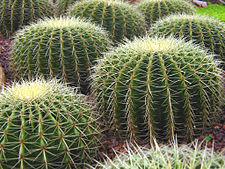
Back Cactaceae Afrikaans صبار Arabic صبار ARZ কেক্টাছ Assamese Cactaceae AST Achakaña Aymara Kaktuskimilər Azerbaijani کاکتوس AZB Kakteengwachsa BAR Kaktus BCL
| Cactus Temporal range: Late Eocene - Recent
| |
|---|---|
 | |
| Various Cactaceae from Brockhaus' Konversations-Lexikon v. 2 1892 | |
| Scientific classification | |
| Kingdom: | Plantae |
| Clade: | Tracheophytes |
| Clade: | Angiosperms |
| Clade: | Eudicots |
| Order: | Caryophyllales |
| Family: | Cactaceae Juss.[1] |
| Subfamilies | |
|
See also Classification of the Cactaceae | |
| Synonyms[2] | |
| |
A cactus (pl.: cacti, cactuses, or less commonly, cactus)[3] is a member of the plant family Cactaceae (/kækˈteɪsi.iː, -ˌaɪ/),[a] a family of the order Caryophyllales comprising about 127 genera with some 1,750 known species.[4] The word cactus derives, through Latin, from the Ancient Greek word κάκτος (káktos), a name originally used by Theophrastus for a spiny plant whose identity is now not certain.[5] Cacti occur in a wide range of shapes and sizes. They are native to the Americas, ranging from Patagonia in the south to parts of western Canada in the north, with the exception of Rhipsalis baccifera, which is also found in Africa and Sri Lanka. Cacti are adapted to live in very dry environments, including the Atacama Desert, one of the driest places on Earth. Because of this, cacti show many adaptations to conserve water. For example, almost all cacti are succulents, meaning they have thickened, fleshy parts adapted to store water. Unlike many other succulents, the stem is the only part of most cacti where this vital process takes place. Most species of cacti have lost true leaves, retaining only spines, which are highly modified leaves. As well as defending against herbivores, spines help prevent water loss by reducing air flow close to the cactus and providing some shade. In the absence of true leaves, cacti's enlarged stems carry out photosynthesis.
Cactus spines are produced from specialized structures called areoles, a kind of highly reduced branch. Areoles are an identifying feature of cacti. As well as spines, areoles give rise to flowers, which are usually tubular and multipetaled. Many cacti have short growing seasons and long dormancies and are able to react quickly to any rainfall, helped by an extensive but relatively shallow root system that quickly absorbs any water reaching the ground surface. Cactus stems are often ribbed or fluted with a number of ribs which corresponds to a number in the Fibonacci numbers (2, 3, 5, 8, 13, 21, 34 etc.). This allows them to expand and contract easily for quick water absorption after rain, followed by retention over long drought periods. Like other succulent plants, most cacti employ a special mechanism called "crassulacean acid metabolism" (CAM) as part of photosynthesis. Transpiration, during which carbon dioxide enters the plant and water escapes, does not take place during the day at the same time as photosynthesis, but instead occurs at night. The plant stores the carbon dioxide it takes in as malic acid, retaining it until daylight returns, and only then using it in photosynthesis. Because transpiration takes place during the cooler, more humid night hours, water loss is significantly reduced.
Many smaller cacti have globe-shaped stems, combining the highest possible volume for water storage with the lowest possible surface area for water loss from transpiration. The tallest[b] free-standing cactus is Pachycereus pringlei, with a maximum recorded height of 19.2 m (63 ft),[7] and the smallest is Blossfeldia liliputiana, only about 1 cm (0.4 in) in diameter at maturity.[8] A fully grown saguaro (Carnegiea gigantea) is said to be able to absorb as much as 200 U.S. gallons (760 L; 170 imp gal) of water during a rainstorm.[9] A few species differ significantly in appearance from most of the family. At least superficially, plants of the genera Leuenbergeria, Rhodocactus and Pereskia resemble other trees and shrubs growing around them. They have persistent leaves, and when older, bark-covered stems. Their areoles identify them as cacti, and in spite of their appearance, they, too, have many adaptations for water conservation. Leuenbergeria is considered close to the ancestral species from which all cacti evolved. In tropical regions, other cacti grow as forest climbers and epiphytes (plants that grow on trees). Their stems are typically flattened, almost leaf-like in appearance, with fewer or even no spines, such as the well-known Christmas cactus or Thanksgiving cactus (in the genus Schlumbergera).
Cacti have a variety of uses: many species are used as ornamental plants, others are grown for fodder or forage, and others for food (particularly their fruit). Cochineal is the product of an insect that lives on some cacti.
Many succulent plants in both the Old and New World – such as some Euphorbiaceae (euphorbias) – are also spiny stem succulents and because of this are sometimes incorrectly referred to as "cactus".[citation needed]
- ^ Cite error: The named reference
APGIII2009was invoked but never defined (see the help page). - ^ Cite error: The named reference
gbif.orgwas invoked but never defined (see the help page). - ^ Cite error: The named reference
MerriamWebsterwas invoked but never defined (see the help page). - ^ Cite error: The named reference
Christenhusz-Byng2016was invoked but never defined (see the help page). - ^ Johnson, A.T.; Smith, H.A. & Stockdale, A.P. (2019), Plant Names Simplified: Their Pronunciation, Derivation & Meaning, Sheffield, Yorkshire: 5M Publishing, p. 26, ISBN 9781910455067
- ^ Cite error: The named reference
LAtimeswas invoked but never defined (see the help page). - ^ Cite error: The named reference
Sala00was invoked but never defined (see the help page). - ^ Cite error: The named reference
mausethwas invoked but never defined (see the help page). - ^ Cite error: The named reference
npswas invoked but never defined (see the help page).
Cite error: There are <ref group=lower-alpha> tags or {{efn}} templates on this page, but the references will not show without a {{reflist|group=lower-alpha}} template or {{notelist}} template (see the help page).

